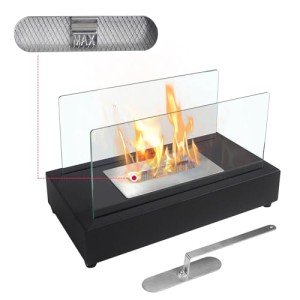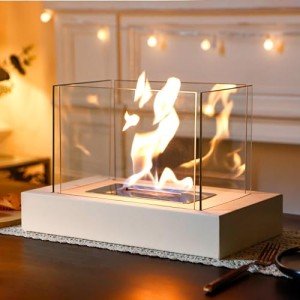In recent years, the demand for unique and versatile home accessories has led to a surge in popularity of tabletop ethanol fire pits. These modern heating solutions provide warmth and ambiance while serving as stylish conversation starters for both indoor and outdoor settings. In this article, we will explore the features, benefits, installation, and maintenance of ethanol fire pits, and evaluate how they are transforming living spaces.
Understanding Tabletop Ethanol Fire Pits
Tabletop ethanol fire pits are compact fire features that burn bioethanol, a clean-burning, renewable fuel. Unlike traditional wood-burning or gas fire pits, ethanol fire pits emit minimal smoke and odors, making them suitable for both indoor and outdoor use. The design often emphasizes aesthetics, integrating seamlessly with various décor styles, from modern minimalist to rustic charm.
Key Features
Tabletop ethanol fire pits come with a variety of specifications and designs. Common features include:
- Portability: Many models are lightweight, making them easy to move from one location to another.
- Design Versatility: Available in various shapes, sizes, and materials, including glass, metal, and ceramic.
- Safety Measures: Most models include safety features like tempered glass windshields, stainless steel burners, and flame control sections.
- Ease of Use: Fueled by readily available bioethanol fuel, these fire pits require minimal setup and maintenance.
Benefits of Ethanol Fire Pits
Ethanol fire pits deliver numerous advantages, making them an appealing choice for homeowners looking to enhance their indoor or outdoor environments. Some notable benefits include:
- Eco-Friendliness: Ethanol is derived from renewable resources, and its combustion releases no harmful pollutants, making it a greener choice.
- No Need for Ventilation: Unlike traditional fireplaces, ethanol fire pits do not require a chimney or flue, providing flexibility in placement.
- No Smoke or Ash: With minimal emissions, users can enjoy the ambiance of a fire without the hassle of cleaning up ash or dealing with smoke inhalation issues.
- Year-Round Use: Suitable for all seasons, ethanol fire pits can warm spaces during chilly evenings or create a cozy atmosphere for entertaining guests.
- User-Friendly: Operating an ethanol fire pit is simple; fill, ignite, and enjoy the flame.
Considerations Before Purchase
While tabletop ethanol fire pits offer myriad advantages, potential buyers should consider the following factors:
- Size and Capacity: Assess available space for placement to ensure the fire pit fits well without being a safety hazard.
- Burn Time: Understand how long the fuel lasts. Many models offer varying burn times based on capacity; typical burn times range from 2 to 6 hours.
- Fuels Used: Ensure the fire pit is compatible with quality bioethanol fuel for optimal performance and safety.
- Safety Regulations: Check local regulations regarding fire features for indoor or patio installations.
Setting Up a Tabletop Ethanol Fire Pit
The setup of an ethanol fire pit is straightforward and generally requires only a few simple steps:
-
Choose a Suitable Location:
- For indoor use, ensure proper ventilation and place on a non-flammable surface.
- For outdoor use, select a space with sufficient distance from flammable materials and overhangs.
-
Prepare the Fire Pit:
- Unpack the fire pit and assemble any required components following the manufacturer’s instructions.
- If equipped with a wick or burner, ensure it is clean and free of debris.
-
Fill with Bioethanol Fuel:
- Pour the bioethanol fuel into the reservoir (avoid overfilling) and allow it to soak in if necessary.
-
Ignite the Fire:
- Use a long lighter or match to ignite the fuel. Ensure to stand at a safe distance while doing so.
-
Enjoy Safely:
- Monitor the fire, and never leave it unattended. Always extinguish the flame before refilling with fuel.
Maintenance Tips
To prolong the life of your tabletop ethanol fire pit and ensure safe operation, adhere to these maintenance guidelines:
- Routine Cleaning: Regularly clean the fire pit to prevent residue buildup; use a damp cloth to wipe down surfaces.
- Fuel Storage: Keep extra bioethanol fuel in a cool, dry place, away from heat sources and flames.
- Safety Checks: Inspect the fire pit for any damage or wear before each use.
FAQs
What is bioethanol fuel?
Bioethanol fuel is a renewable energy source produced from plant materials, primarily sugarcane or corn. When burned, it generates heat and emits primarily water vapor and carbon dioxide.
Can I use a tabletop ethanol fire pit indoors?
Yes, as long as the fire pit has proper ventilation and is positioned away from flammable materials. Always follow the manufacturer’s safety guidelines.
How long does the fuel last in an ethanol fire pit?
Burn times vary based on the size of the fire pit and the amount of fuel used. Typically, a full tank can last between 2 to 6 hours.
Are ethanol fire pits safe?
When used in accordance with manufacturer guidelines and safety regulations, ethanol fire pits are safe. However, users should always monitor the flame and ensure proper ventilation for indoor use.
Can I use regular gasoline in my ethanol fire pit?
No, never use gasoline or other flammable substances in ethanol fire pits. Only use approved bioethanol fuel to ensure safe operation.
Tabletop ethanol fire pits have gained immense popularity due to their eco-friendliness, aesthetic appeal, and versatility. Whether for indoor use on a cold day or as an elegant accent on your outdoor patio, these fire features provide warmth, ambiance, and a unique focal point for entertaining. With careful consideration and maintenance, an ethanol fire pit can enhance the coziness and character of any living space throughout the year.





